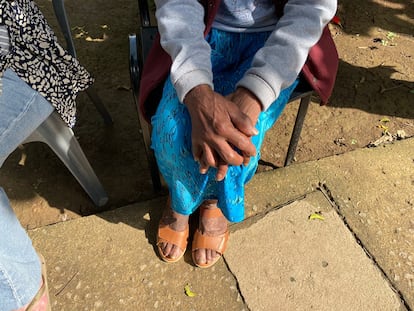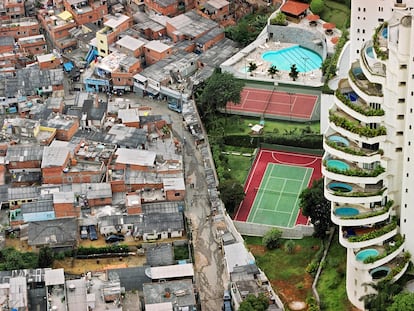Dona Maria, enslaved for 72 years by three generations of a family in Brazil
‘She does not recognize herself as a slave, nor do they see themselves as enslavers,’ says the labor inspector who rescued the 85-year-old domestic worker in Rio de Janeiro. Her case reflects the legacy of three centuries of buying and selling Africans


Dona Maria is 85 years old, and she has lived all her life in her bosses’ house in Río de Janeiro. She is a servant, and for three generations, she was passed down from father to son. The woman’s world was turned upside down on the first Monday in May, when a stranger told her that she would not return to the family with whom she had lived since age 13. Her universe seemed to collapse. She didn’t understand. Distressed, she implored the stranger to let her go back: “The level of submission was clear when she began to say: ‘I have to go back because I have to feed Mrs. Yonne, I have to take care of her, I have to bathe her. If I don’t go back, she’s going to die. She felt absolutely responsible for the life of her employer,” says Alexandre Lyra, the labor inspector who rescued the woman after 72 years working for the Mattos Maia family without a salary or vacation time. Her entire world existed within the four walls of the home. Never in Brazil had such a prolonged case of contemporary slavery been discovered.
In all those years, Dona Maria—a fictitious name given by the authorities to protect her identity—never had a partner, children or friends, nor did she know anything about labor rights. The patron whose welfare was her main concern is also in her eighties. They matured and grew old together, but under wildly different circumstances.
Mrs. Yonne lived in the main bedroom of a house that she shared with her son André. When, after an anonymous complaint, the labor inspector showed up at their house, the Mattos Maias resorted to the most common argument in these cases: “she’s like family.” The explanation often disguises the crime of labor exploitation. The victims are servants to wealthy families that often subject them to inhumane conditions, as with Dona Maria. The old caretaker slept on a sofa in the middle of a hallway outside the landlady’s room, ready to come whenever she was needed. The inspector calculates that the accumulated debt owed to Doña Maria is around 1,5 million reais ($300.000).
Domestic workers are legion in Brazil. They are a pillar in privileged families. The majority are Black and come from very poor families. Dona Maria, who is Black, embodies the legacy of slavery in today’s Brazil: a crime based on a perverse power relationship.
“She does not recognize herself as a slave, nor do they see themselves as enslavers,” emphasizes Lyra, who had never seen such an extreme case. But the situation is not unique. In the last year alone, this inspector has rescued seven other enslaved domestic workers in the city of Rio.
Social worker Thaiany Motta, 33, has treated other victims held for decades by wealthy, seemingly respectable families. She is part of the Integrated Action project, created by the Public Ministry of Labor of Rio de Janeiro and Cáritas when they realized that rescuing these workers was not enough. The program first focuses on reducing the damage of separation trauma. Then they help the victims build independent lives.
Motta sees a clear pattern: “The power relationship to which they are subjected is very strong. It is a bondage based on a debt of gratitude, an emotional and relational debt. They feel compelled to stay because they think that they could be worse off, that at least they have a house and food.” In the last year alone, this professional has treated a dozen women who had been exploited for up to 30, 50 and 70 years. The fact that the crime takes place inside private homes makes it particularly easy to hide. “They are all Black, although one does not consider herself Black,” she says.

Over the years, the victims completely lose their identities, the social worker points out in a telephone interview. “Their whole lives revolve around the interests of the family,” she says. They switch churches, and they begin attending their bosses’ church. When they sit in front of the television, it’s to watch their bosses’ favorite shows. The post-rescue therapy includes activities as simple as going out for ice cream and choosing their own favorite flavor.”
134th anniversary of the abolition of slavery
Dona Maria’s case was made public on Friday, May 13, a date that made the news particularly impactful for Brazilian media and households: it commemorated the 134th anniversary of the abolition of slavery. Princess Isabel signed the so-called Golden Law in 1888 from a Rio de Janeiro palace that stands on a dock where slave ships arrived for three centuries. The inhumane practice that was the basis of the economy in the Portuguese colony was outlawed but not eliminated. That historic palace lies at only 13 kilometers, an hour by bus, from the house where the Mattos Maia family subjected their maid to what is classified as a form of slavery.
After abolition, Brazil did not offer land, work or education to the freedmen, whose labor was soon taken over by white European immigrants. Totally helpless, many former slaves preferred to return to their masters, begging for shelter and food.
Inspector Lyra, 51, recalls other details of Dona Maria’s rescue. The first time she was questioned in the presence of the boss, she kept silent. He responded to the questions on the woman’s behalf and kept her documents. The former maid arrived at a municipal shelter in Rio de Janeiro, where she continues to stay, with the clothes on her back and little else: some documents, a bus pass and a bank card that she did not know how to use. The researchers believe that before the pandemic, she went out to do the shopping once a week. Punishment for employers can range from two to eight years in prison.
When Dona Maria arrived at the shelter, “she was very thin, very afraid. She was reluctant to stay,” says social worker Cristiane Lessa, 40, who received her. There, she is finally sleeping in a bed of her own, and a psychosocial team is helping her rebuild her life. “Now begins the task of deconstructing the idea that she has a family and wants to return to them, an idea built over years of total commitment,” explains Lessa, who works in the area of the Rio City Council that attends to the elderly. The authorities have begun the search for relatives who can take the woman in when she is ready. If not, she will live in a home with other elderly people.
Five years have passed since the Brazilian authorities first rescued an enslaved domestic worker. In the last year, the rescues have increased, because more complaints have been made. This increase is due to several factors. A widely viewed television interview with Madalena Gordiano, exploited since she was eight years old, and whom the courts compensated by giving her the family home, had enormous impact. Many Brazilians came to understand that what was happening in their neighbors’ house was a crime. The awareness-raising work of domestic worker unions and anti-racist movements have also had an effect.
Contemporary domestic slaves often come from backgrounds of enormous need and abuse. Dona Maria was born on the farm of her current employer’s grandparents, where her parents were settlers. When she was a teenager, she was sent to serve the Mattos Maia in Rio. When she moved to the newly built Brasilia, she had already spent a decade cleaning, washing, ironing and cooking, in exchange for only shelter and food. Six more decades passed. Brazil lived through a dictatorship, a World Cup and an Olympic Games. At 85 years old, Doña Maria is now trying to overcome the most recent trauma in order to savor her freedom.
Tu suscripción se está usando en otro dispositivo
¿Quieres añadir otro usuario a tu suscripción?
Si continúas leyendo en este dispositivo, no se podrá leer en el otro.
FlechaTu suscripción se está usando en otro dispositivo y solo puedes acceder a EL PAÍS desde un dispositivo a la vez.
Si quieres compartir tu cuenta, cambia tu suscripción a la modalidad Premium, así podrás añadir otro usuario. Cada uno accederá con su propia cuenta de email, lo que os permitirá personalizar vuestra experiencia en EL PAÍS.
¿Tienes una suscripción de empresa? Accede aquí para contratar más cuentas.
En el caso de no saber quién está usando tu cuenta, te recomendamos cambiar tu contraseña aquí.
Si decides continuar compartiendo tu cuenta, este mensaje se mostrará en tu dispositivo y en el de la otra persona que está usando tu cuenta de forma indefinida, afectando a tu experiencia de lectura. Puedes consultar aquí los términos y condiciones de la suscripción digital.
More information
Últimas noticias
Most viewed
- Sinaloa Cartel war is taking its toll on Los Chapitos
- Oona Chaplin: ‘I told James Cameron that I was living in a treehouse and starting a permaculture project with a friend’
- Reinhard Genzel, Nobel laureate in physics: ‘One-minute videos will never give you the truth’
- Why the price of coffee has skyrocketed: from Brazilian plantations to specialty coffee houses
- Silver prices are going crazy: This is what’s fueling the rally










































